Credit Cycle Set to Deteriorate in 2023
US2US…
+-2.95%
Add to/Remove from Watchlist
Add to Watchlist
Add Position
Position added successfully to:
Please name your holdings portfolio
Type:
BUY
SELL
Date:
Amount:
Price
Point Value:
Leverage:
1:1
1:10
1:25
1:50
1:100
1:200
1:400
1:500
1:1000
Commission:
Create New Watchlist
Create
Create a new holdings portfolio
Add
Create
+ Add another position
Close
The entire financial system revolves around credit. At the heart of this system lies the ability of corporations and consumers to access credit, which is largely driven by the economic cycle and the willingness of commercial banks to lend and supply credit. This in turn drives credit spreads, asset returns and volatility.
As the business cycle continues to trend lower, the latest Fed loan officer survey highlighted how restrictive commercial banks’ lending practices are becoming, with credit availability across the board reaching the tightest levels since the COVID-19 recession. This is true of commercial and industrial loans to corporations, credit card loans to consumers, as well as auto loans. All are at levels seen only during recession. Commercial Bank Lending Standards
Commercial Bank Lending Standards
When credit conditions are loose and corporations can easily borrow, credit spreads are low as the risk of default reduces. This usually corresponds to periods of accelerating economic growth and abundant liquidity as corporations are overly optimistic and risk-seeking.
However, as the business and liquidity cycles decelerate and monetary policy conditions tighten, credit availability falls as banks are less willing to lend. For corporations and consumers who have overextended themselves with debt to spend and invest beyond their means, this is particular troublesome.
One of the most reliable leading indicators of credit availability is the yield curve. As the curve inverts, bank margins are squeezed and thus their incentive to lend fall. As such, the percentage of banks who are tightening lending standards tends to increase.
Banks profit from the spread of an upward sloping yield curve as they borrow on the short-end of the curve and lend at the long end. This spread evaporates when the yield curve inverts. As we know, all iterations of the yield curve are inverted and have been for some time, so this tightening of lending standards was to be expected (though appears yet to be priced in, as we will discuss below).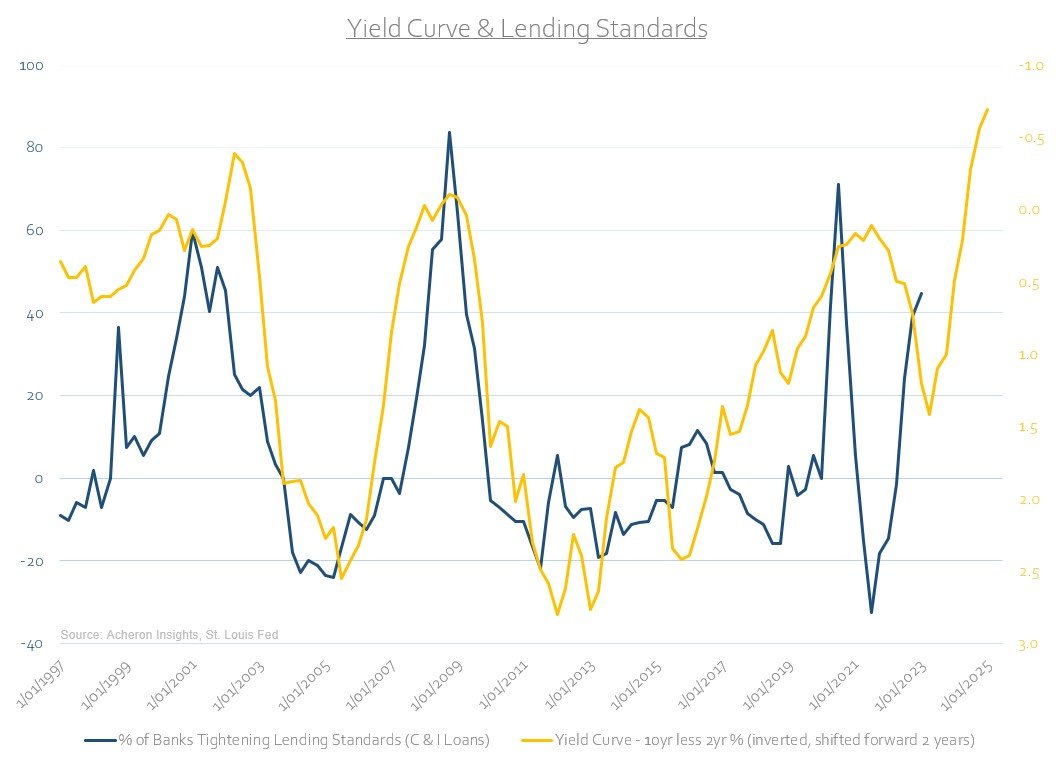 Yield Curve and Lending Signals
Yield Curve and Lending Signals
When lending standards tighten the ability for corporations and consumers to access credit is severely hindered. This is why we see loan growth follow lending standards, which I have proxied below via commercial and industrial loans, but the relationship is true most types of credit. Indeed, 2023 should therefore see loan growth roll over.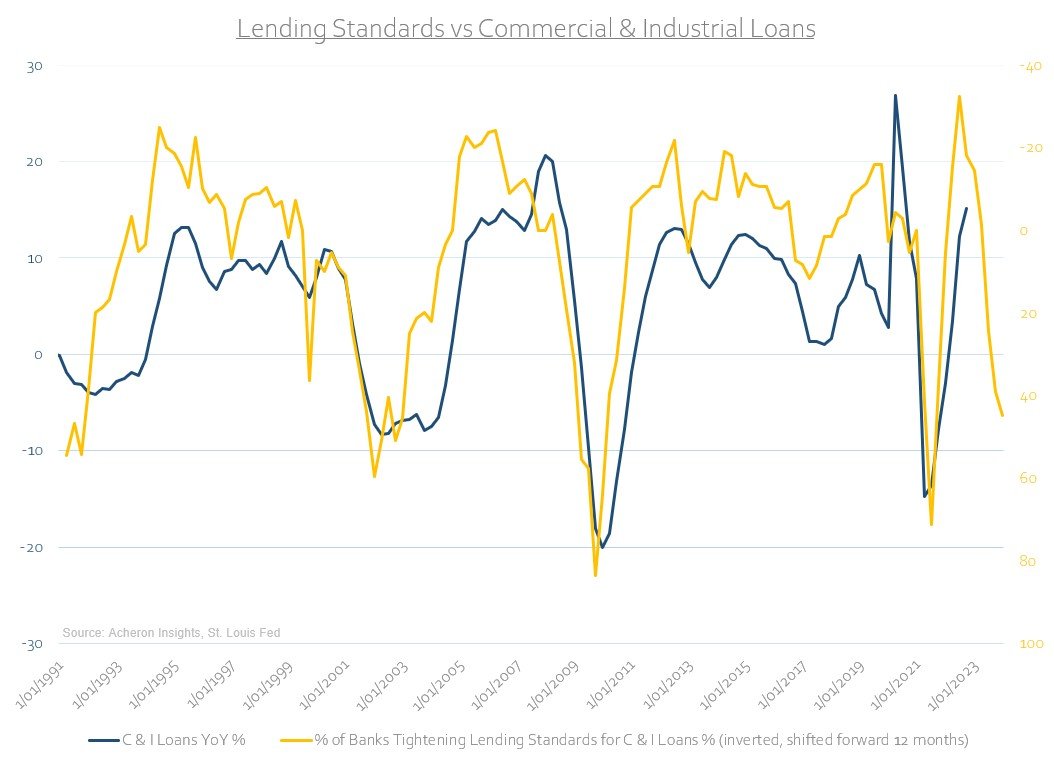 Lending Standards Vs. Commercial and Industrial Loans
Lending Standards Vs. Commercial and Industrial Loans
All told, this dynamic eventually finds its way into higher credit spreads, particularly for those of a lower credit rating. A reduction in the availability of credit leads to increased financial stress for overleveraged companies who cannot access credit when they need it most.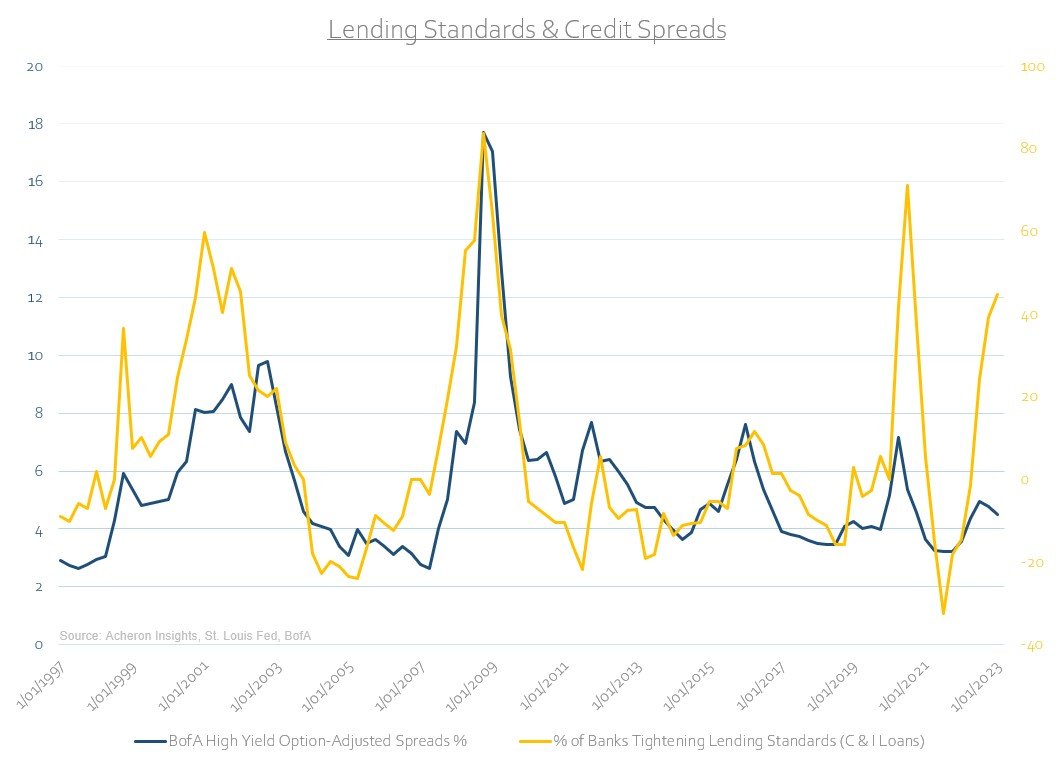 Lending Standards Vs. Credit Spreads
Lending Standards Vs. Credit Spreads
No soft-landing in sight
None of this bodes well for the soft-landing narrative. The leading indicators of the credit cycle continue to suggest higher credit spreads and are likely in the months ahead. In addition to tighter lending standards driving credit spreads higher, higher interest rates do the same.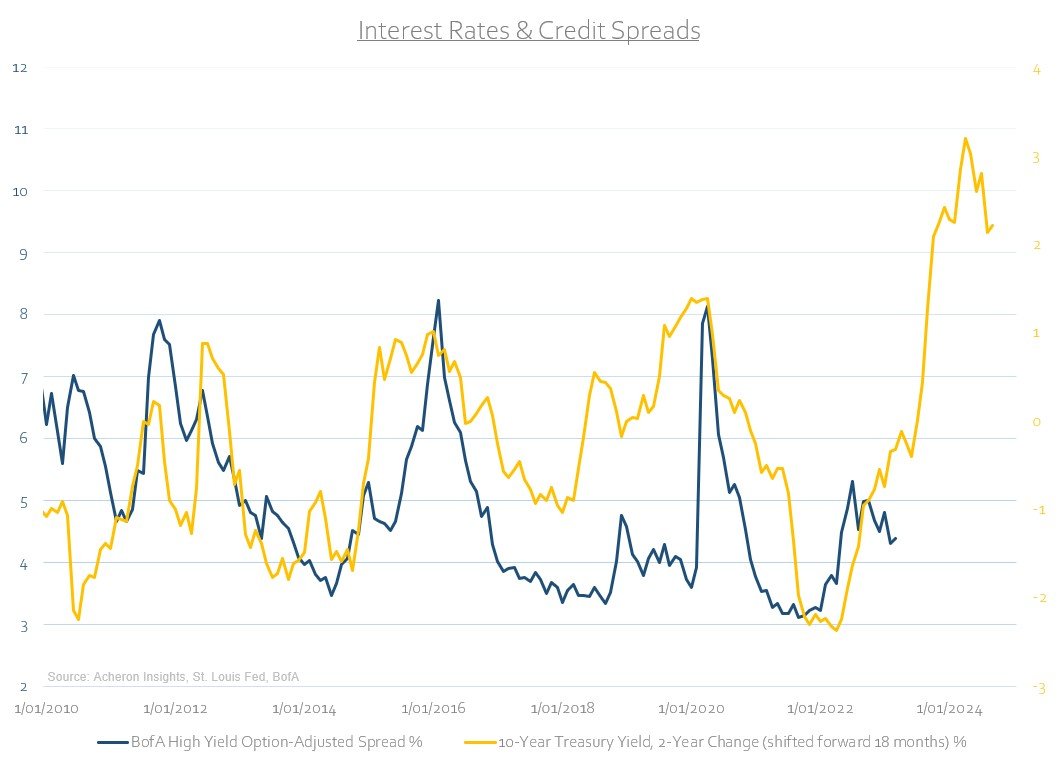 Interest Rates Vs. Credit Spreads
Interest Rates Vs. Credit Spreads
As do tighter central bank policy conditions. Global Central Bank Policies Vs. Credit Spreads
Global Central Bank Policies Vs. Credit Spreads
As it stands, the pricing of the credit market is not reflective of this outlook for the credit cycle. As we can see below, BofA’s high yield OAS is pricing a manufacturing PMI of above 50, indicative of a growing economy.


Indeed, as flagged recently via ZeroHedge, Bloomberg’s Simon White noted high-yield credit is pricing only a 20% chance of recession. Considering the outlook for the credit cycle highlighted herein along with the outlook for the business cycle itself, there appears to be a significant level of mispricing at present. For whatever reason, the credit market is betting on a soft landing.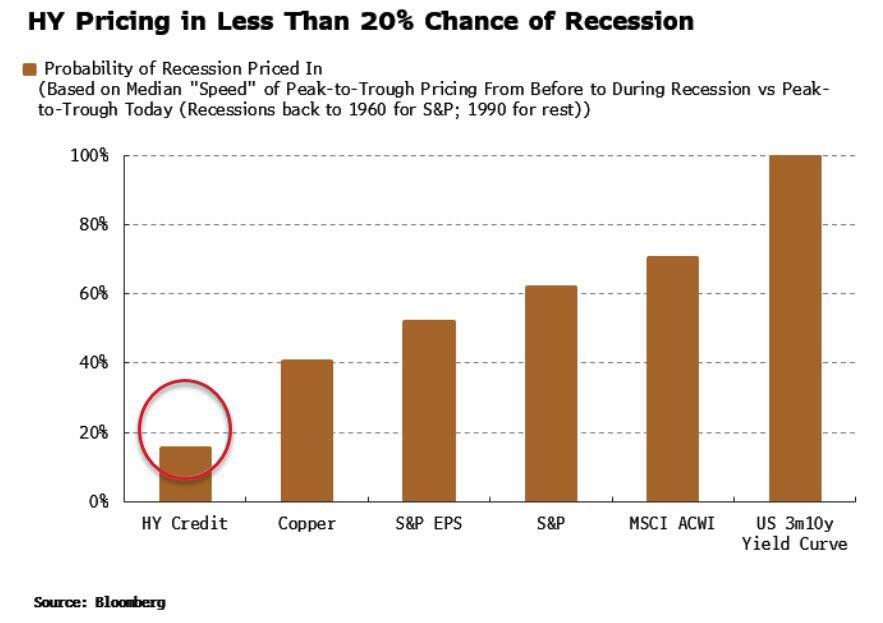 Probability of a Recession Already Priced in
Probability of a Recession Already Priced in
This will not end well
With the deterioration of the credit cycle looming, the unfortunate consequences will be pain for both financial markets and the real economy. Again, as credit spreads rise and bank lending standards tighten, access to credit becomes increasingly difficult for both corporations and individuals. This in turn puts great strain on corporate balance sheets and ultimately, corporate profitability. Credit spreads themselves tend to lead corporate earnings by around six months, so, while we may see corporate earnings hold up relatively well for the first half of 2023 in-line with EPS estimates, we know this is only temporary. Credit Spreads Vs. S&P 500 Earnings
Credit Spreads Vs. S&P 500 Earnings
As higher spreads eventually find their way into earnings, they will in-turn lead to increased delinquency rates for both consumers and corporations as the burden of higher borrowing costs impacts those who are most vulnerable.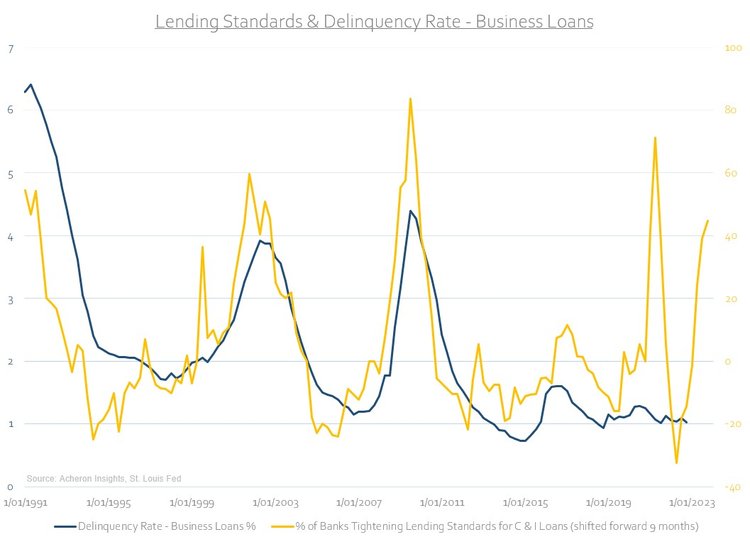 Lending Standards Vs. Delinquency Rate
Lending Standards Vs. Delinquency Rate Lending Standards Vs. Delinquency Rate (Credit Cards)
Lending Standards Vs. Delinquency Rate (Credit Cards)
And thus, this ultimately will lead to increased defaults and bankruptcies.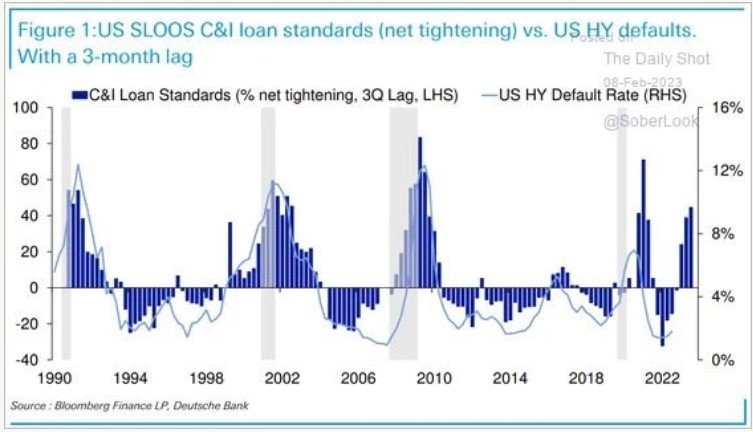 U.S. SLOOS C&I Loan Standards Vs. U.S. HY Defaults
U.S. SLOOS C&I Loan Standards Vs. U.S. HY Defaults
And eventually, higher unemployment as firm’s lay off workers and these effects ripple through the real economy. Lending Standards Vs. Unemployment Rate
Lending Standards Vs. Unemployment Rate
None of this bodes well for the stock market. As I have detailed in the past, the credit cycle is one of the best leading indicators of volatility. As credit spreads rise, volatility ensures. Credit Spreads Vs. Volatility
Credit Spreads Vs. Volatility
Unsurprisingly, bank stocks are particularly vulnerable to this dynamic, at least on a relative basis. Global Banks Vs. Non-Financials and U.S. SLO Survey
Global Banks Vs. Non-Financials and U.S. SLO Survey
There is simply no need to take credit risk
With short-dated Treasury yields at their current levels, there is simply no need to take meaningful amounts of credit risk at present. This can be argued of duration risk as well. The FT’s Robert Armstrong highlighted this point recently in excellent fashion,
Indeed, extending this point to the matter at hand, Armstrong notes  U.S. Treasury Yields
U.S. Treasury Yields
From a macro perspective, I find it hard to argue with this analysis. Now is not the time to wander too far down the risk curve, and credit is no exception.





